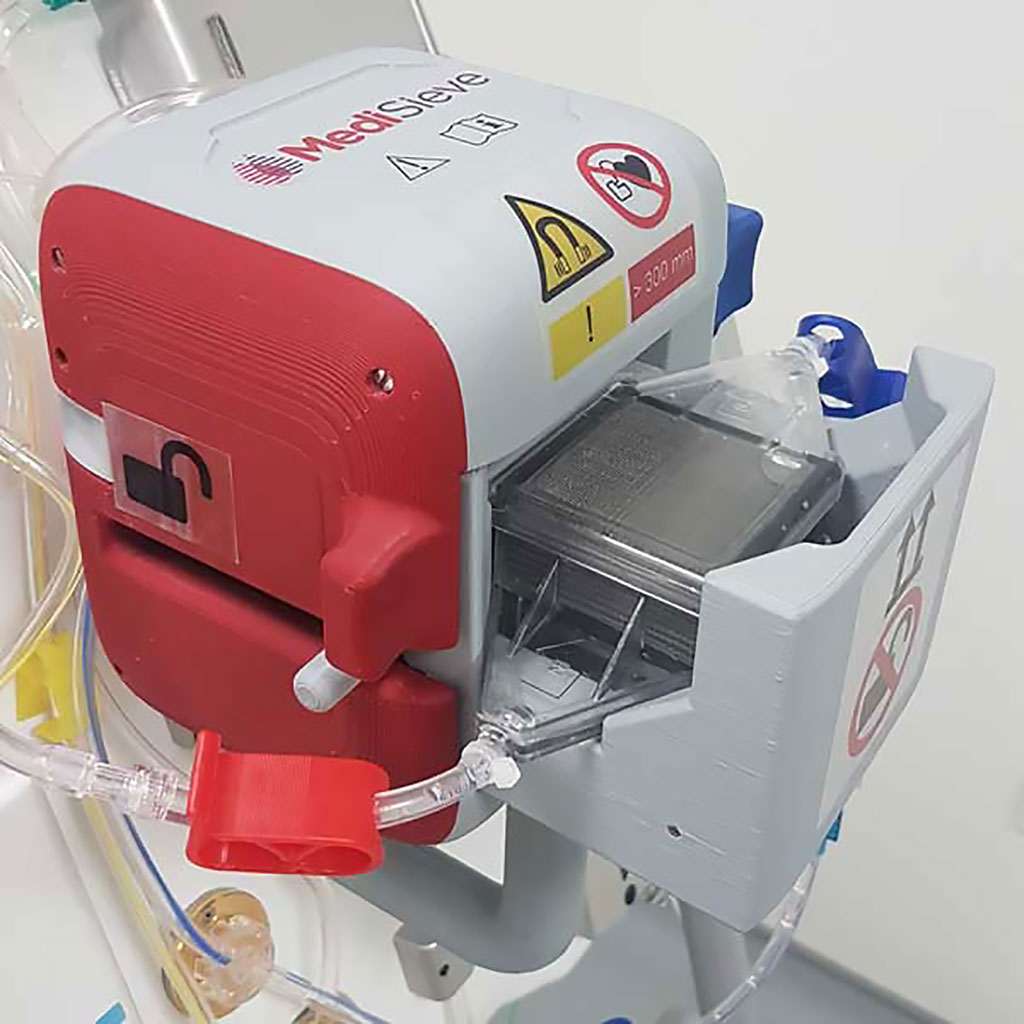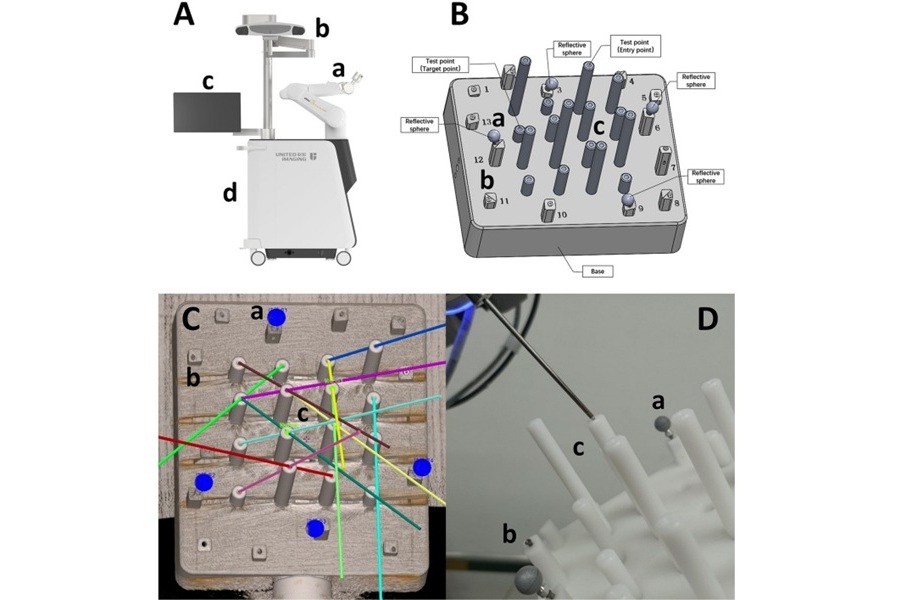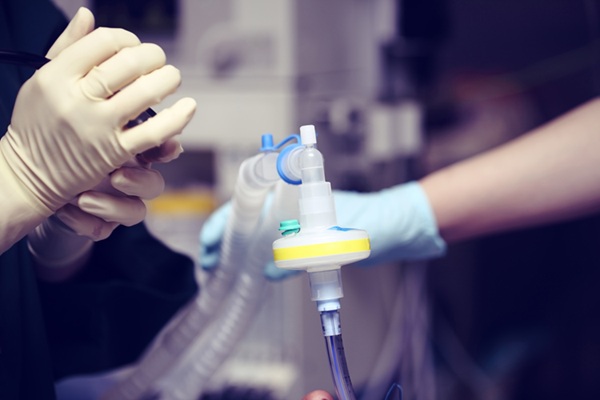Magnetic Blood Filtering System Draws out Disease
|
By HospiMedica International staff writers Posted on 03 Dec 2019 |

Image: The MediSieve magnetic blood filtering system (Photo courtesy of MediSieve)
An innovative blood filtering system could draw out deadly infections such as malaria and sepsis from the body using magnets.
The MediSieve (London, United Kingdom) filtering technology works in a similar way to dialysis. Blood is taken from a patient and infused with the MediSieve magnetic particles, which attach to specific targets so that they can be subsequently captured by a magnetic filter and removed from the blood before it is pumped back into the body. Particle size, magnetic properties, and number of binding agents coating the nanoparticles are all engineered to ensure maximal capture and removal by the filter. The whole process takes around two to four hours.
“In theory, you can go after almost anything. Poisons, pathogens, viruses, bacteria, anything that we can specifically bind to, we can remove. So, it’s a very powerful potential tool,” said George Frodsham, CEO and founder of MediSieve. “When someone has a tumor, you cut it out. Blood cancer is a tumor in the blood, so why not just take it out in the same way? Now we know it’s possible; it’s just a question of figuring out some of the details.”
Blood can be repeatedly passed through the system until the target is at such a low concentration that the immune system or a short course of medication can remove it. The first disease due to be tested for device efficacy is malaria; interestingly, in this case, the first step is not necessary, as malaria targets iron-rich blood cells and consumes hemoglobin, turning it magnetic. Further trials will be conducted to see whether the nanoparticles can remove sepsis-causing bacteria and tone down the deadly immune response.
“Malaria treatment is our flagship product because the infected cells have naturally occurring magnetic properties. The malaria parasite invades the red blood cell and consumes the hemoglobin, and therefore it leaves an iron-based waste product, which it then takes inside itself. So effectively malaria parasites poop is magnetic, and then it eats its poop,” explained Mr. Frodsham. “We really feel we can have a material human impact to help those suffering the most from the disease, particularly children and pregnant women.”
Related Links:
MediSieve
The MediSieve (London, United Kingdom) filtering technology works in a similar way to dialysis. Blood is taken from a patient and infused with the MediSieve magnetic particles, which attach to specific targets so that they can be subsequently captured by a magnetic filter and removed from the blood before it is pumped back into the body. Particle size, magnetic properties, and number of binding agents coating the nanoparticles are all engineered to ensure maximal capture and removal by the filter. The whole process takes around two to four hours.
“In theory, you can go after almost anything. Poisons, pathogens, viruses, bacteria, anything that we can specifically bind to, we can remove. So, it’s a very powerful potential tool,” said George Frodsham, CEO and founder of MediSieve. “When someone has a tumor, you cut it out. Blood cancer is a tumor in the blood, so why not just take it out in the same way? Now we know it’s possible; it’s just a question of figuring out some of the details.”
Blood can be repeatedly passed through the system until the target is at such a low concentration that the immune system or a short course of medication can remove it. The first disease due to be tested for device efficacy is malaria; interestingly, in this case, the first step is not necessary, as malaria targets iron-rich blood cells and consumes hemoglobin, turning it magnetic. Further trials will be conducted to see whether the nanoparticles can remove sepsis-causing bacteria and tone down the deadly immune response.
“Malaria treatment is our flagship product because the infected cells have naturally occurring magnetic properties. The malaria parasite invades the red blood cell and consumes the hemoglobin, and therefore it leaves an iron-based waste product, which it then takes inside itself. So effectively malaria parasites poop is magnetic, and then it eats its poop,” explained Mr. Frodsham. “We really feel we can have a material human impact to help those suffering the most from the disease, particularly children and pregnant women.”
Related Links:
MediSieve
Latest Critical Care News
- Smart Nanomaterials Detect and Treat Traumatic Brain Injuries Simultaneously
- Earlier Blood Transfusion Could Reduce Heart Failure and Arrhythmia in Heart Disease Patients
- 'Smart' Shirt Detects Epileptic Seizures in Real Time
- Skin Patch Measures Effectiveness of Flu/COVID Vaccines in 10 Minutes
- Complete Revascularization Reduces Risk of Death from Cardiovascular Causes
- Tiny Fish-Inspired Robots Navigate Through Body to Deliver Targeted Drug Therapy
- Coronary Artery Stenosis Could Protect Patients from Pulmonary Embolism Effects
- Sweat-Powered Sticker Turns Drinking Cup into Health Sensor
- Skin-Mounted 3D Microfluidic Device Analyzes Sweat for Real-Time Health Assessment
- New Therapeutic Brain Implants to Eliminate Need for Surgery
- Stem Cell Patch Gently Heals Damaged Hearts Without Open-Heart Surgery
- Biomaterial Vaccines to Make Implanted Orthopedic Devices Safer
- Deep Learning Model Predicts Sepsis Patients Likely to Benefit from Steroid Treatment
- Programmable Drug-Delivery Patch Promotes Healing and Regrowth After Heart Attack
- Breakthrough Ultrasound Technology Measures Blood Viscosity in Real Time
- Magnetically Activated Microscopic Robotic Swarms Could Deliver Medicine Inside Body
Channels
Surgical Techniques
view channelGroundbreaking Procedure Combines New Treatments for Liver Tumors
Removing or destroying liver tumors often requires patients to undergo two separate procedures, exposing them to multiple hospital stays, repeated anesthesia, and longer recovery times. Traditional approaches... Read moreAblation Reduces Stroke Risk Associated with Atrial Fibrillation
Atrial fibrillation (AFib) greatly increases the risk of stroke, blood clots, heart failure, and death, and millions of people in the U.S. are expected to be affected in the coming years.... Read morePatient Care
view channel
Revolutionary Automatic IV-Line Flushing Device to Enhance Infusion Care
More than 80% of in-hospital patients receive intravenous (IV) therapy. Every dose of IV medicine delivered in a small volume (<250 mL) infusion bag should be followed by subsequent flushing to ensure... Read more
VR Training Tool Combats Contamination of Portable Medical Equipment
Healthcare-associated infections (HAIs) impact one in every 31 patients, cause nearly 100,000 deaths each year, and cost USD 28.4 billion in direct medical expenses. Notably, up to 75% of these infections... Read more
Portable Biosensor Platform to Reduce Hospital-Acquired Infections
Approximately 4 million patients in the European Union acquire healthcare-associated infections (HAIs) or nosocomial infections each year, with around 37,000 deaths directly resulting from these infections,... Read moreFirst-Of-Its-Kind Portable Germicidal Light Technology Disinfects High-Touch Clinical Surfaces in Seconds
Reducing healthcare-acquired infections (HAIs) remains a pressing issue within global healthcare systems. In the United States alone, 1.7 million patients contract HAIs annually, leading to approximately... Read moreHealth IT
view channel
Printable Molecule-Selective Nanoparticles Enable Mass Production of Wearable Biosensors
The future of medicine is likely to focus on the personalization of healthcare—understanding exactly what an individual requires and delivering the appropriate combination of nutrients, metabolites, and... Read moreBusiness
view channel
Philips and Masimo Partner to Advance Patient Monitoring Measurement Technologies
Royal Philips (Amsterdam, Netherlands) and Masimo (Irvine, California, USA) have renewed their multi-year strategic collaboration, combining Philips’ expertise in patient monitoring with Masimo’s noninvasive... Read more
B. Braun Acquires Digital Microsurgery Company True Digital Surgery
The high-end microsurgery market in neurosurgery, spine, and ENT is undergoing a significant transformation. Traditional analog microscopes are giving way to digital exoscopes, which provide improved visualization,... Read more
CMEF 2025 to Promote Holistic and High-Quality Development of Medical and Health Industry
The 92nd China International Medical Equipment Fair (CMEF 2025) Autumn Exhibition is scheduled to be held from September 26 to 29 at the China Import and Export Fair Complex (Canton Fair Complex) in Guangzhou.... Read more













